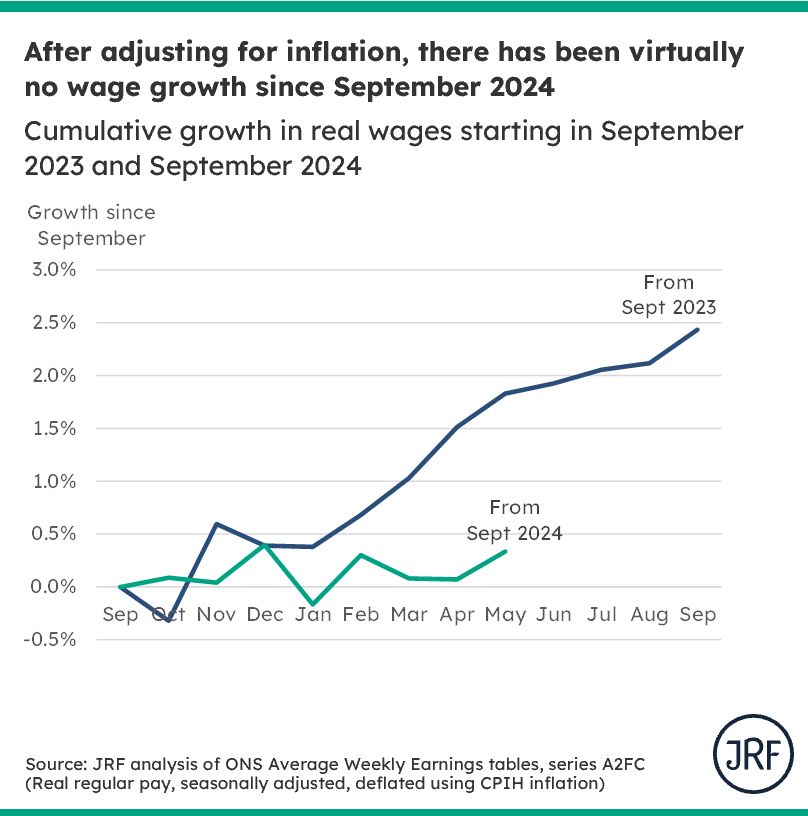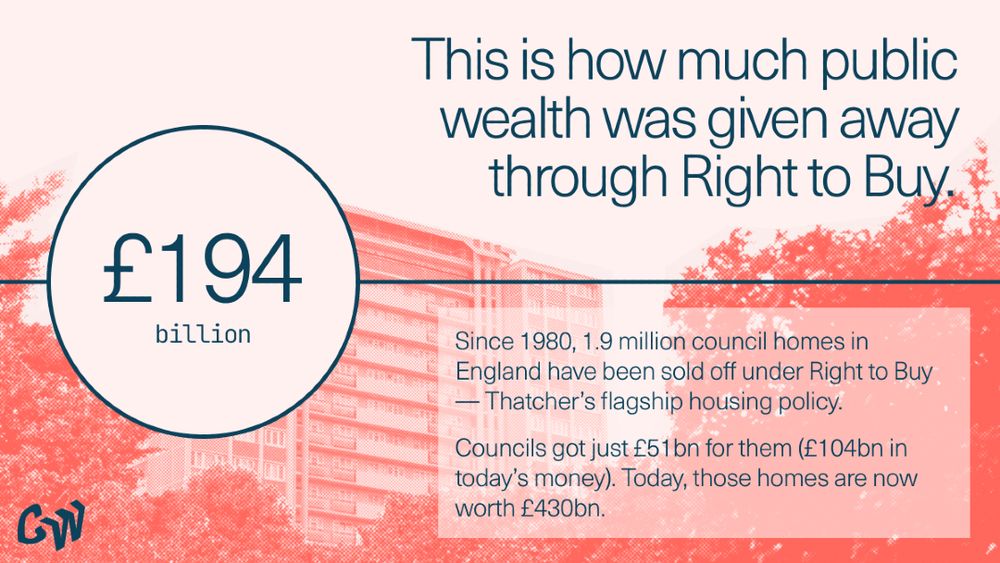
And finally - the trends in tenure shifts are seen across England, but more pronounced in some places than others..
11.09.2025 07:17 — 👍 5 🔁 0 💬 0 📌 0@jelliott94.bsky.social
Lead analyst at the Joseph Rowntree Foundation @jrf-uk.bsky.social Posting about politics, poverty, housing, benefits and work. Northern Irish, views my own.

And finally - the trends in tenure shifts are seen across England, but more pronounced in some places than others..
11.09.2025 07:17 — 👍 5 🔁 0 💬 0 📌 0
P.s. It seems very unlikely that brexit had a meaningful impact on the trends we reported here.
Also evidence that many landlords switched to incorporation or short lettings as more tax efficient or profitable ventures - important govt rebalances this.

Tax reform quietly helped reshaped the housing market: fewer landlords, more first-time buyers, no clear harm to tenants.
Read more in our @jrf-uk.bsky.social report
www.jrf.org.uk/housing/reba...
In our report we suggest some ways in which Government could double down on these tax changes including closing incorporation loop-holes and equalising the tax paid on income from property with income from earnings.
11.09.2025 07:17 — 👍 3 🔁 0 💬 1 📌 0We need to see a ramping up in the delivery of new homes.
But we don’t need the PRS to start expanding again – new supply can flow into owner occupation and affordable housing, especially social rent.
Still, too many face unaffordable, poor quality, or overcrowded housing, while more young adults are stuck living with parents into their 20s and 30s.
A root cause is not enough homes generally.

In fact our analysis, and analysis by the ONS, finds that the average share of income spent on rent has edged down slightly since 2016. This holds for lower income households too.
11.09.2025 07:17 — 👍 4 🔁 0 💬 2 📌 0Private renting is still too costly, insecure and often poor quality – pushing many into poverty.
But we found no evidence that the 2016 tax changes made things worse. (And the RRB will rebalance the relationship, giving tenants more stability and security
The upshot?
More young people getting on the housing ladder – building equity instead of paying their landlords mortgage. Achieving their aspirations of home ownership and putting down roots.
But what about those still renting?

Among middle-to-high income 20-34 year olds, home ownership rose from a low of 40% in 2015/16 to 47% by 2023/24.
There are now over a million more owner occupied homes than if the pre-2016 trend had been followed.

After 2016 growth in buy-to-let lending slowed from 25% a year to just 1%.
Instead first-time buyer lending expanded, increasing from an avg. of £11bn a year to 2015 to on avg. £18bn a year since (in todays money). Their share of new lending increased from 23% to 41%.


With fewer landlords buying, plus government support and family wealth transfers, first-time buying picked up and the rate of owner occupation increased, reversing years of falling homeownership rates.
11.09.2025 07:17 — 👍 6 🔁 0 💬 1 📌 0
Why? One big factor is tax changes.
Ending mortgage interest relief and a higher stamp duty slowed new landlord purchases, net effect being that the sector has held fairly constant in size since 2016 rather than continuing to expand.
Everyone knows the private rented sector ballooned after 2000. What’s less commented on: it flatlined after 2016 – and the rate of owner occupation started to recover.
(Note official stats don’t any shrinking of the PRS to 2024)

New report: Taxing landlords more is good, actually.
Since 2016, tax reforms helped slash the growth of the private rented sector and boosted first-time buyers—without hurting existing tenants.
A big housing story hiding in plain sight? ⬇️
Some great graphs, maps and useful analysis in the ONS publication, here:
www.ons.gov.uk/peoplepopula...

Figure 3: The North East and East Midlands had the most affordable rents and the lowest range of affordability ratios
Across 1/3rd of local authorities in England and Wales, average expenditure of incomes on rent was over 30%, a commonly accepted measure of unaffordability.
Every London local authority was above this threshold. Bristol, Bath, Brighton & commuter towns were also v expensive.

Figure 2: Private rents were above the affordability threshold in FYE 2024 for England, mainly because of high ratios for London
On average across England private renters spent 36% of incomes on rent, increasing to 42% in London.
This compares to 26% in Wales and 25% in Northern Ireland. The North East of England is most affordable with private rents at on average around 20% of incomes.

Figure 1: Private rents have been consistently above 30% in England, below 30% in Northern Ireland, and usually below 30% in Wales
ONS have published new private rented affordability analysis for 2024.
Ratios of rents to incomes dipped in 2022/23 as incomes climbed faster than rents.
Rents have been catching up so affordability has worsened again and seems likely it will continue to worsen through 2025...
We’re hiring a Media Manager 📢
Can you identify compelling news stories that resonate with the mainstream media and political debates?
Do you thrive in shaping strategy and working with colleagues to turn policy ideas into media successes?
Apply: jrf.octo-firstclass.co.uk/candidates/c....

A chart showing how regular wages are growing after taking account of inflation. The first few months of the period starting September 2023 showed relatively slow growth, but there was consistent growth between February 2024 and September 2024, meaning wages grew by 2.4% over the year. This latter period is in contrast to the period starting September 2024, where growth has hovered around zero. Between September 2023 and May 2024, wages grew 1.8%, but in the same period a year later, they grew just 0.3%.
Ahead of tomorrow’s Monetary Policy Report, look at how real earnings have stagnated since September. They’re up just 0.3% between September 2024 and the latest May 2025 data, just a fifth of the growth over the same period in 2023-24. (1/5)
06.08.2025 18:08 — 👍 9 🔁 6 💬 1 📌 2
💰 How much public wealth do you think was given away for free via Right to Buy?
1bn? 10bn? 100bn?
Try 200 BILLION pounds.
🧵 Here's how Britain’s most infamous housing policy became its biggest housing disaster — and near the largest privatisation in British history.

Govt dropped cuts to PIP, but today's Committee report highlights MPs' concerns that many disabled people will be pushed into poverty by remaining cuts to Universal Credit's health element. In evidence to the inquiry I warned of the hardship this will cause. 1/5
www.theguardian.com/politics/202...
New job alert 📢
We're hiring a Senior Policy Advisor for our Scotland office.
If you believe as passionately as we do that we can deliver a fairer Scotland free from poverty then this job could be for you. 🔽 1/3
We've seen some encouraging steps from Government towards tackling this issue with the Renters Rights Bill and additional funding for social housing.
We also need to see more decision active to make private renting more affordable.

Graph showing numbers of children and households living in temporary accommodation in England. 169,000 children and 131,000 households are living in temporary accommodation; arresting this escalating crisis must be a key priority for Government
There are now twice as many children living in temporary accommodation as when Labour were last in Government.
Arresting this escalating crisis needs to be a key priority for Government.


Homes with low energy efficiency ratings were much more likely to have damp.
Residents were far more likely to report being unable to keep their home warm if they were living in homes with damp.


Homes in more deprived areas are more likely to be of poor quality.
There are stark trends in the types of homes that tend to be non-decent, with much higher rates of non-decency among converted flats and terraced homes.


Unsurprisingly those living in a poorer quality or damp home was associated with much lower levels of satisfaction with that home.
Living in a non-decent home is associated with a 30-40% increase in expenditure on average energy costs across tenures.